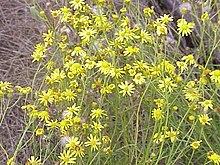Narrow-leaved ragwort
| Narrow-leaved ragwort | ||||||||||||
|---|---|---|---|---|---|---|---|---|---|---|---|---|

Narrow-leaved ragwort ( Senecio inaequidens ) |
||||||||||||
| Systematics | ||||||||||||
|
||||||||||||
| Scientific name | ||||||||||||
| Senecio inaequidens | ||||||||||||
| DC. |
The narrow-leaved weed ( Senecio inaequidens ) is a plant of the genus Senecio ( Senecio ) in the family of Compositae (Asteraceae). Its original home is in South Africa and Lesotho . It is an invasive plant in many parts of the world . In Central Europe today it is one of the most common groundwort species.
features
Narrow-leaved ragwort grows as a short-lived, perennial herbaceous plant . Overall, the plants reach heights of growth of 30 to 60 cm. It contains toxic pyrrolizidine alkaloids in all parts of the plant .
The most characteristic feature, as the German common name suggests, is the shape of the leaves : They are linear to narrowly lanceolate, only 1 to 5 mm wide and around 6 cm long. Basically, they are finely and sharply serrated, although the leaf edge can sometimes be rolled up a little, so that the leaves look whole at first glance. At the base, the leaves half enclose the stem with a small ear .
The flowering period begins in early summer (around June) and only ends with the onset of winter (around the end of November). The overall inflorescence is rather loose and heavily branched. The flower heads are 2 to 2.5 cm in diameter. An outer shell, i.e. H. there is a second row of bracts around the flower head. There are usually ten to thirteen yellow ray-flowers in each cup . The fruits (nuts) are pappus and the seeds are spread by the wind.
The chromosome number is 2n = 20 or 40.
Occurrence
The original home of the narrow-leaved ragwort is in the capensis .
It was introduced as a wool adventitious plant as early as the 19th century . For a long time it was adventurous, often with only a few specimens at the places where it was introduced (mostly ports), and was inconsistent. Since the 1970s, however, it conquered large parts of Central Europe from the northwest in a short time. Today the species is a neophyte in southern, central and northern Europe. In Switzerland, it was included in the black list of invasive neophytes in Switzerland due to its spreading potential and the damage in the areas of biodiversity , health and economy and made subject to the release ordinance.
The neophyte often forms conspicuous, yellow-blooming mass populations, especially along highways (motorways) and railway lines. It also grows on dry ruderal sites , e.g. B. on construction sites, at (freight) train stations , on roadsides, in industrial areas , etc. The short-lived perennial herbaceous plant thrives sociologically primarily in annual (annual) ruderal or rocky corridors (Sisymbrietalia) , in biennen (two-year) ruderal corridors (Onopordetalia) , in ruderal grass grass (Agropyretea intermedii-repentis) and in dry sand grass (Sedo-Scleranthetea) .
swell
- Henning Haeupler, Thomas Muer: picture atlas of the fern and flowering plants of Germany . Ed .: Federal Agency for Nature Conservation (= The fern and flowering plants of Germany . Volume 2 ). Eugen Ulmer, Stuttgart (Hohenheim) 2000, ISBN 3-8001-3364-4 .
- Wolfgang Adler, Karl Oswald, Raimund Fischer: Excursion flora of Austria . Ed .: Manfred A. Fischer. Eugen Ulmer, Stuttgart / Vienna 1994, ISBN 3-8001-3461-6 .
- Erich Oberdorfer : Plant-sociological excursion flora . With the collaboration of Theo Müller. 6th, revised and expanded edition. Eugen Ulmer, Stuttgart (Hohenheim) 1990, ISBN 3-8001-3454-3 .
- Uwe Starfinger, Ingo Kowarik, Maike Isermann : Senecio inaequidens DC. (Asteraceae), narrow-leaved ragwort. In: Neoflora. Invasive alien plants in Germany. Federal Agency for Nature Conservation, accessed on May 9, 2020 .
Individual evidence
- ↑ Senecio inaequidens , chromosome number at Tropicos.org. Missouri Botanical Garden, St. Louis, accessed on May 18, 2016.
- ↑ Senecio inaequidens in the Germplasm Resources Information Network (GRIN), USDA , ARS , National Genetic Resources Program. National Germplasm Resources Laboratory, Beltsville, Maryland. Retrieved March 10, 2018.
- ^ Federal Office for the Environment FOEN: Invasive Alien Species . ( admin.ch [accessed on August 6, 2019]).
- ↑ S. Buholzer, M. Nobis, N. Schoenenberger, S. Rometsch: List of the alien invasive plants of Switzerland . Ed .: Infoflora. ( infoflora.ch [accessed on August 6, 2019]).
further reading
- Ullrich Asmus: The penetration of neophytes into anthropogenically created locations and their socialization using the example of Senecio inaequidens DC. In: Flora. Volume 180, No. 1-2, 1988, pp. 133-138.
- Hans Jürgen Böhmer : The narrow-leaved ragwort (Senecio inaequidens DC. 1837) in Germany - a current inventory. In: Floristic Newsletters. Volume 25, 2002, pp. 47-54, Bochum.
- Reinhard Bornkamm: Causes and limits of the spread of Senecio inaequidens DC. in Central Europe - shown using the example of Berlin / Brandenburg. In: Negotiations of the Botanical Association of Berlin and Brandenburg. Volume 136, 2006, pp. 9-26, Berlin.
- Tina Heger, Hans-Jürgen Böhmer: The invasion of Central Europe by Senecio inaequidens DC .: a complex biogeographical problem. In: Geography. Volume 59, No. 1, 2005, pp. 34–49, DOI: 10.3112 / geography . 2005.01.03 .
- Ute Lange: Narrow-leaved ragwort - A neophyte reaches the city of Fulda In: Beech leaves - Supplement of the Fuldaer Zeitung for Heimatfreunde, number 20 of October 17, 2012 p. 80.
Web links
- Narrow-leaved ragwort. In: FloraWeb.de.
- Narrow-leaved ragwort . In: BiolFlor, the database of biological-ecological characteristics of the flora of Germany.
- Profile and distribution map for Bavaria . In: Botanical Information Hub of Bavaria .
- Senecio inaequidens DC. In: Info Flora , the national data and information center for Swiss flora .
- Thomas Meyer: Greiskraut data sheet with identification key and photos at Flora-de: Flora von Deutschland (old name of the website: Flowers in Swabia )
- Augustin Pyrame de Candolle: Prodromus systematis naturalis regni vegetabilis. Volume 6, 1838 ("1837"), p. 401 (first description)
- further literature on Senecio inaequidens in the literature database vegetation ecology

